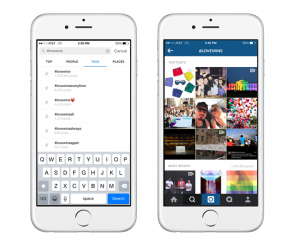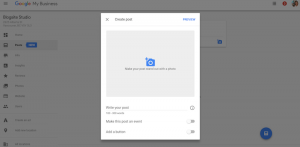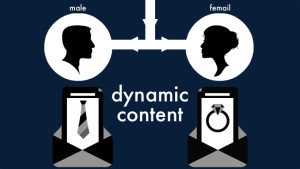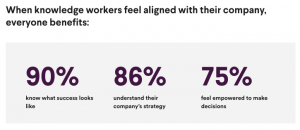Influencer marketing is one of the most effective marketing channels. At least 90% of the Influencer Marketing Hub survey respondents believe it.
Many B2C brands use influencer marketing as a part of their marketing activities. Nothing is surprising about that. Collaborations with popular bloggers in your niche often perform better than regular posts and ads on a company’s social pages.
However, measuring the effect of influencer marketing is the biggest challenge, 62% of marketers said. Brands have been using this channel more recently. There is no set of commonly used metrics. That is, most specialists don’t know how to evaluate the results. Many of them just run these trending campaigns ignoring how influencer marketing affects their business.
Despite all the challenges, in this article, we’ll try to find a way to monitor your activities with influencers to detect failures and reveal best practices. Let’s stop guessing games about influencer marketing!
Why do businesses need influencer marketing?
The best thing about this marketing channel is that it works for various campaigns, big and small. Collaborating with influential people in the industry, startups can get exposure across socials, companies operating in competitive niches can earn credibility, and solid brands can refresh their content strategies.
Sometimes influencers, both micro and macro, become your company’s spokespersons. They share some information about your products or services and talk about it with their audiences. Their impact on thousands of loyal followers — they are your prospects if you collaborate with the right bloggers — helps build a strong community around your brand.
Also, you can run a plethora of blatant ad campaigns with influencers rolling out new items, activating the holiday sales, or raising your brand awareness. There is a higher chance these activities will wrap it better than Facebook post boosting and paid Instagram Stories.
Why does it work?
Usually, bloggers with a big following learn their subscribers to a T. They know the best time for posting, use a fully appropriate tone of voice in their messages, and create highly authentic content. However, the key point is they are humans, not companies, alive, imperfect, and unique.
On social networks, people follow people. They search for their soulmates, advisors, even trusted friends and often find them amid bloggers. No brand can achieve this level of trust with the audience.
As a result, influencer marketing relies on the high credibility bloggers have. It is worth more than the number of visitors, the average view time, or the domain rating. That is why even micro-influencers who resonate with your brand can generate leads for you.
Since many customers use social media for purchasing advice, there are no good reasons to avoid influencer marketing in your social activities.
How to measure influencer marketing performance?
The influencer marketing campaign is basically a social media campaign. It means measuring the effect of a collaboration, you may use the same social media metrics. Besides, there are some specific indicators for influencer campaigns.
Let’s break it down.
-
Return on Investment (ROI)
This metric is the cornerstone of many marketing activities for its versatility.
To measure your influencer marketing ROI, you can use this simple formula:
ROI = (Profit return/Total amount spent)*100
For instance, a beauty blogger shot a video showcasing a new lipstick you produce with your brand’s mention in the caption.
Say the price of the collaboration is $ 250. During the first week after the video was published, you generated $ 1500 in profit. The ROI of the campaign is:
(1500/250)*100 = 600% ROI
What a result! It seems you need to think about a long-term cooperation with this influencer.
-
Conversions
This way of measuring is much easier than the previous one. Tracking the number of conversions from an influencer’s page or a particular post is all you need to use this method.
The term conversion has various meanings. Generally speaking, it refers to the number of people who performed a target action, for instance, clicking the link to your web page.
A lot of beauty brands collaborate with YouTube bloggers to promote their products. Usually, influencers add a trackable link in the video description box or offer unique promo codes for their subscribers.
For example, this description contains several links with UTM parameters that enable companies to identify how much traffic to the website this video drives. The visitor acquisition by this campaign is a conversion.
- Cost per Click (CPC)
You can dive deeper into the conversion metrics and calculate the cost per click. CPC is based on the number of times followers click on an ad post attached to the website and the ad price.
You can use this formula to determine CPC for your influencer campaign:
CPC = Advertising cost/number of clicks
The simple logic is behind this indicator. The more people clicked on your ad, the more successful (and cheaper in terms of marketing budget) your collaboration was.
By the way, you can use an average CPC as a criterion when you are looking for bloggers to collaborate with. Many influencers are ready to provide you with these statistics dedicated to your industry.
-
Click-through Rate (CTR)
CTR gives you a little more information about followers’ interaction with a post, video, or text that an influencer shared with them. It is a ratio between people who click on the link in the post and people who view it in their feed.
Follow this formula to calculate CTR for your collaboration:
CTR = (Total number of clicks/Total number of views)*100
For instance, a YouTube clip with your product showcasing is viewed by 1000 people. 300 of them clicked the link to your landing page. The CTR is:
(300/1000)*100 = 30% CTR
As a quick point, in the formula, the total number of views can be changed with Impressions if you estimate CTR for influencer campaigns on Facebook and Instagram. This metric shows how many times a post appears to users.
The best rate can significantly vary depending on your niche and product peculiarities.
A 2% CTR is considered by marketing specialists as a good result.
-
Referral traffic
Most likely, you can see the same name line in your Acquisition Google Analytics report. It shows the sources — Referrals — that drive traffic to your website, except the major search engines.

Social media networks can be these sources as well as blogs, news and review sites, media outlets. In this case, influencers keep the links to your website active on their pages for a long time that convert referrals into constant traffic sources for you.
The Google Analytics report indicates how many visitors from referrals you have and what pages of your website they open first. It enables you to check whether your collaboration with a blogger performs well or not.
-
List growth
It is one of the major metrics for email marketing specialists. However, you can use it in influencer marketing, too. List growth shows how quickly your subscribers or followers number grows.
Here is a formula for you:
(New followers – Unsubscribed users)/Total followers = List growth
When you run an influencer campaign to grow your following, it is helpful to monitor this metric.
Additionally, you can compare List growth rate to Referral traffic metrics. That will give you insight into why some channels may perform better. Then, you can adjust your influencer marketing strategy accordingly.
-
Influencer audience loyalty
Boosting online presence with paid subscribers takes place amid bloggers. There are dozens of websites where anyone can buy subscribers for a YouTube channel or get followers for an Instagram page for money. Many bloggers try to bring more recognition to their profiles quickly in this way.
However, you hope to reach a responsive and loyal audience by running an influencer campaign. Paid subscribers hardly reciprocate.
Checking influencer audience loyalty will help you avoid unsuccessful collaborations. How to measure it?
Many social listening and media monitoring tools provide the sentiment analysis feature. These tools scan social platforms by keywords, brand names, or social handles you type in as a search query. Then, they analyze the data with the help of AI algorithms and reveal the number of positive, negative, and neutral mentions of a brand or influencer name. For instance, in Awario, there are illustrative sentiment stats.
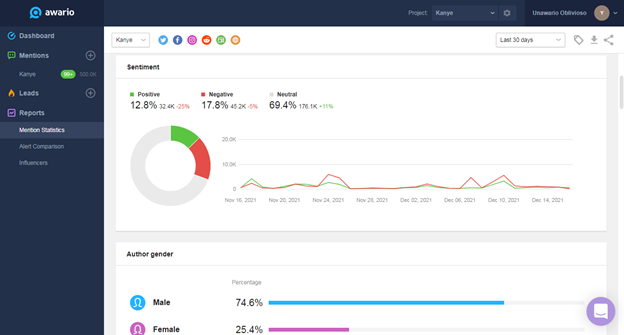
- Awario shows the sentiment of Kanye West’s mentions on the web
If the sentiment of an influencer is rather negative than positive, think again about whether it is worth collaborating with this blogger.
-
Channel authority
This metric is complicated because it is hard to put social credibility on one number or formula. Channel authority is composed of several aspects: the number of following, posting activity, engagement, the content visibility.
On social networks, followers are a reaction to good content, not the cause. You can pay attention to the number of retweets or shares as a signal that this person’s ideas resonate with people. They are willing to share these tweets, Reels, Facebook posts as an expert opinion.
Additionally, influencer marketing tools and popular social accounts databases define the Influencer score for each profile. Although this is a pretty rough rate, you can use it as a reference point.
-
Engagement
The engagement rate is measured by the number of likes and comments on your post.
While likes refer to the audience’s attitude to content — on Instagram, they tend to like all posts with beautiful and aesthetic visuals — comments indicate whether the topic is important for followers or not. That’s why measuring engagement is a bit tricky.
Influencers with thousands of followers can earn hundreds of likes that people put without thinking of what the post is about. A great many comments are evidence of the influential power a blogger has got. Engaged followers are ready to discuss the topic, ask questions, argue, participate in giveaways or contests that influencers promote. Their attention is a super valuable asset in social feeds overloaded with information.
-
Social media reach
The last key performance indicator — reach — shows how many views your post can potentially earn. Social media reach depends on the number of followers and a blogger’s page promotion activity.
For instance, some influencers are active on two or three social platforms at once. Twitch bloggers often go online on YouTube, Instagram bloggers repurpose their Reels on TikTok. It brings their content into focus for big audiences.
To calculate reach, you can use social media monitoring tools again. These tools measure your reach on Facebook, Twitter, Instagram, and other social platforms.
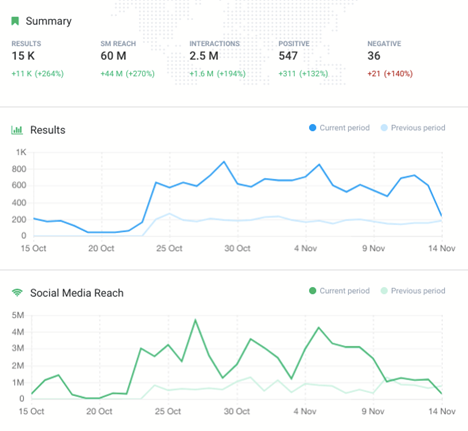
- Brand24 reach metrics
Source: https://brand24.com/blog/how-to-measure-social-media-reach/
Also, you can check the reach stats that social networks themselves reveal.
Is your influencer marketing program a success?
Finally, go to your original goals to check if the past influencer campaign helped you achieve them. What do you want to get collaborating with a blogger? Is the number of your followers raised? Did you sell more items? Has your brand sentiment and reach changed?
Additionally, try to give a rating for an influencer you have collaborated with. Does he/she meet deadlines, keep agreements, respond to your answers without delays? Gradually, you can create a database of reliable and trusted influencers to run new campaigns on different social networks. Probably, some bloggers will be in your bad books. That is a result, too.
Digital & Social Articles on Business 2 Community
(73)


